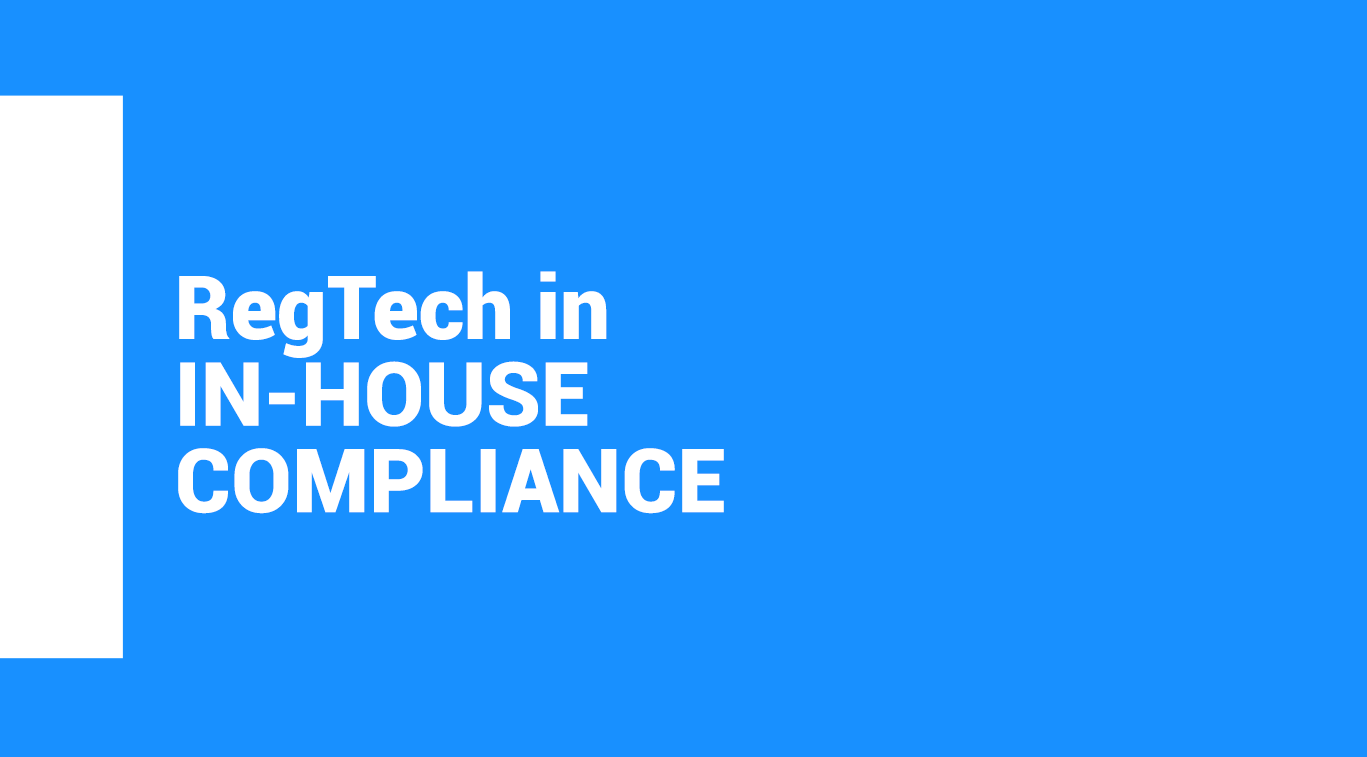RegTech in In-House Compliance

Written by Joshua Fraser
Blogger

When it comes to law and legal tech, legal adjacent careers, which do not directly involve qualified legal professionals, are often left out of the limelight, or indeed even the whole dialogue on how the legal field is developing.
This is an oversight that is sorely in need of correction. A myriad of legal-allied roles, where the law is practised by learned individuals who are nonetheless not on either the SRA’s Solicitor’s Register or the Bar Standards Board Register, make up an increasing proportion of legal traffic in UK Markets, as companies attempting to cut outsourcing costs have increasingly turned to in-house solutions to deal with their legal obligations.
This trend and practice, of home-grown legal adjacent roles, is most prevalent in private limited companies. In particular, the domain of in-house compliance often sees many professionals from a variety of backgrounds, such as accountancy, legal studies (both qualified and unqualified), economics and many more, enter to perform vital roles in ensuring that their employer complies with regulations relevant to everyday practices in their industry.
Chiefly, the role of a compliance officer that is showing increasing demand over the past year, of up to 76%. This growth is primarily due to two driving factors:
Increasing Regulation:
The former of these factors in increasing regulation, coupled with the delayed bite of post-2008 regulatory reform. It is now commonly accepted, particularly in governmental circles, that the financial crisis of 2008 was borne from a laissez-faire approach to market regulation, where companies acted as their own regulators, in the sense that they both set and reviewed their own parameters for sustainable business practices. Self-regulation remains a controversial topic, with some arguing that self-regulation can be an effective corporate strategy that produces a responsible and viable long-term market model.
Conversely, others argue that the practice is inherently susceptible to the human impulse of cupidity and therefore is a moral hazard, which produces scandal-prone and loophole-ridden frameworks that can in turn be easily undermined by bad-faith actors. Regardless of which side of the debate one falls on, it is evident that those abusing self-regulation in the past, by offering mislabelled financial products and granting inherently insecure mortgages brought, in the short term, many powerful economies to their knees, with considerable further long-term consequences.
The economically devastating result of 2008 engendered a financial and corporate regulatory drive in many jurisdictions, including that of the UK. These governmentally introduced guidelines and regulations ostensibly serve, through the punishment of non-compliance, to mitigate the social, environmental and economic risks posed by day-to-day business operations.
This of course placed, and continues to place, pressure on businesses to meet the ballooning regulatory guidelines that pertain to their given field of operation. However, while post-2008 regulatory drives have changed the working dynamic of many of the UK’s key industries, nascent regulations continue to be implemented since this initial large push, such as the FCA’s new control over credit limit rules, which dictate that lenders must engage in a set series of steps to help their borrowers break out of spirals of persistent debt.
Cost of Outsourced Legal Expertise:
At an initial thought, complying with all this increasing regulation might potentially be a process that could be outsourced to an external legal service provider. However, businesses today are constantly attempting to minimise their legal spending, by as much as 30-50%.
Reflecting the trend in other areas of legal work, the proliferating compliance workload is being supported by less and less capital, as firms seek to invest their financial resources in departments that they perceive to be more positively productive, in terms of producing financial output, as opposed to the negative of avoiding losses. As a result, firms have been progressively seeking in-house solutions to the issue of compliance.
This is not a new phenomenon, as compliance officers and in-house compliance departments have existed for quite some time, but they have never been under as much pressure as they are today, and with businesses growing increasingly adverse to outward legal spending, this pressure is one of the main reasons why compliance professionals are in such high demand currently.
The Future Role of Tech in Compliance Work:
Complying with regulatory guidelines is an arduous process, which requires both significant expertise and dedicated time management. For example, a standard private equity firm, which holds capital for investment on trust for its clients, will principally be seeking to maximise the return for their investors and acquire further clients. These dual aims primarily involve extensive market analysis and committed account management to fulfil.
The professionals working in either of these core departments may not have the expertise, nor crucially the time to engage in reviewing the relevant regulations and parameters which delineate what they should and should not do in the course of their day to day business.
This is where in-house compliance departments come in. Compliance officers working in these sections serve to prevent, limit and mitigate any liability which might be incurred by the non-compliance of their given company.
The main objective of compliance departments, that of liability reduction, appears very similar to the main function of in-house legal departments. Indeed, the functions compliance departments often overlap with in-house legal departments, in terms of harmonising business practices with their statutory guidelines.
It is this similarity of practice that not only exposes in-house compliance departments to the same pressures as legal divisions, but also allows them to benefit from the potential rewards and advantages of legal tech support systems.
For instance, much of a compliance officer’s workload involves the conventional practice of reviewing internal documents for errors, areas for improvement and potential sources of regulatory liability. In order to maximise efficiency and the speed of this document review procedure, many compliance departments have instituted non-digital document management processes. While these undoubtedly expand the amount of material a compliance department can review and filter in a given time period, it is still a complex and voluminous process, which takes many man-hours to complete.
One way in which compliance departments could reduce document management system costs is by instituting and utilising the emerging field of AI legal document review. While this field is in the late stages of nascency, the benefits of a document management system, when turbo-charged by computing power, are well known and have been instituted since the day conventional, non-intuitive, accountancy spreadsheets were supplanted by Excel, with its integrated formulas and functions.
Indeed, the UK Legal Tech sector has been at the forefront of considering varied applications of artificial intelligence in the legal sector when compared to the lacklustre technological development of global legal competitors. Recently, the focus of AI in legal tech has been progressively shifting to the sub-domain of regulation, with the apt moniker of ‘RegTech’.
AI is particularly impactful in the field of RegTech as the systematic process of document review is quite amenable to digital systemisation, in much the same way as certain areas of litigation are.
As an illustration, while compliance checking is a complex task, an intuitive and strategic compliance officer could make use of the algorithmic processes of weak AI to set search parameters for certain phrases or sections in a given bundle of documents, much like the ‘ctrl + f’ function of many word processors today, to quickly locate all given instances of the specific element they are looking to review. However, the application of AI can go beyond this initial rudimentary search function and can automatically check to see if certain conditions are true or false, thus flagging which elements require direct attention and which fall within an acceptable ‘margin of error’ specified earlier by the human programmer. This would allow the human operator to only focus on elements that specifically require their attention – drastically reducing the amount of time required to analyse documentation. However, what is even more exciting about automated case management is that it is capable of self-improvement.
While weak AI relies heavily on pre-delineated frameworks and boundaries to guide its actions, it is nonetheless capable of organic self-advancement. AI’s self-instituted and progressive development mainly flourishes through the phenomenon known as machine learning. This is a process whereby a machine takes huge quantities of data, both new and previously synthesised, and subjects them to progressive algorithmic processes, such as neural networks, to sort information at a faster pace and provide the AI’s system with insights into how to more efficiently analyse data sets.
Over time the application of this ‘learning process’ allows the computational system to become increasingly sophisticated and impactful. Examples abound, such as algorithms today being capable of identifying cancerous masses with a now frighteningly high accuracy rate, when compared to their previous performance levels. What this could produce for compliance departments is a tool that not only aids their workers in their everyday tasks, but also improves itself and advances to the point of offering its operators new insights into how to more efficiently review documentation.
This process has been turbo-charged over recent years, as mass digitisation of regulatory texts has led to greater and greater data availability and quality. It is predicted that this wealth of data will allow RegTech programmes to not only analyse documents, but also be able to identify which areas of regulation require the most attention and to be able to intuitively decide what directives/guidelines need to be applied to a particular piece of documentation at any given time.
Conclusion:
Much like other applications of AI in the legal sector, RegTech is an emergent field that not only improves the performance of regulatory departments, but also stands to revolutionise how they function, in a way that Cloud based law software stands to revolutionise mainstream legal departments. It is for this reason that RegTech is one of the hottest emerging appliances for UK compliance departments.
References:
[1] ‘The Importance of Compliance in an Organisation’, Careers in Compliance at https://www.careersincompliance.co.uk/article/the-importance-of-compliance-in-an-organisation/#:~:text=The%20compliance%20function%20clarifies%20the,a%20system%20of%20intuitive%20compliance.
[2] Alexander S. Gillis, ‘What is Compliance’, Tech Target at https://www.techtarget.com/searchdatamanagement/definition/compliance
[3] ‘Ten Things: Building a Strong Compliance Department’, Sterling Miller at https://sterlingmiller2014.wordpress.com/category/compliance/
[4] Pavle Avramovic et al, ‘The Future of RegTech – What do Firms Really Want?’ at https://www.fca.org.uk/insight/future-regtech-what-do-firms-really-want
[5] ‘RegTech in Financial Services’, PWC at https://www.pwc.com/us/en/industries/financial-services/research-institute/top-issues/regtech.html
[6] Vincenzo Lalli ‘The Law Firm Model, The More-For-Less Challenge and Legal Techs Low Hanging Fruit’, Legal Business World https://www.legalbusinessworld.com/post/2019/04/23/the-law-firm-model-the-more-for-less-challenge-and-legal-techs-low-hanging-fruit
[7] Richard Susskind,‘A Response to the More for Less Dilemma’, Harvard Law School – Center on The Legal Profession (Speaker’s Corner’) at https://thepractice.law.harvard.edu/article/speakers-corner-richard-susskind/
[8] ‘Financial Markets Regulatory Outlook 2022’, Deloitte at https://www2.deloitte.com/uk/en/pages/financial-services/articles/regulatory-outlook.html
[9] ‘The Cost of Compliance in the Changing World of Regulation’, Thomson Reuters at https://legal.thomsonreuters.com/en/insights/articles/cost-compliance-changing-world-regulation
[10] Sean Ross, ‘What Major Financial Sector Laws Followed the 2008 Crisis’, Investopedia at https://www.investopedia.com/ask/answers/063015/what-are-major-laws-acts-regulating-financial-institutions-were-created-response-2008-financial.asp








